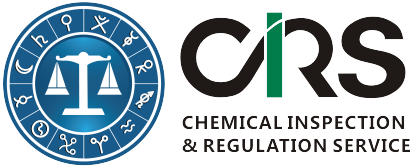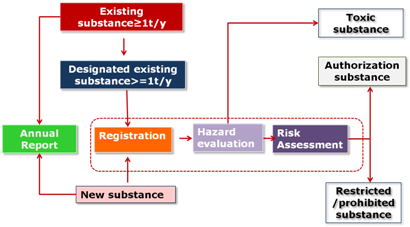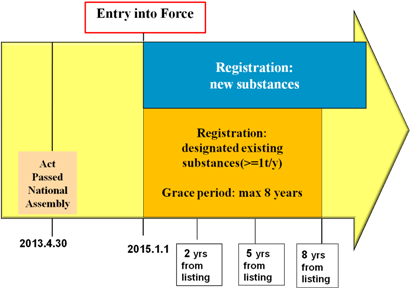Korea REACH - The Act on the Registration and Evaluation of Chemicals
Updated in June 2013, The Act on the Registration and Evaluation of Chemicals(known as Korea REACH) passed the plenary session of the National Assembly in Korea on April 30, 2013 and will come into force on Jan 1, 2015. The purpose of this Act is to protect public health and the environment through these provisions:
- Registration of chemical Substances;
- Screening of hazardous chemical substances;
- Hazard and risk assessment of products containing chemical substances and hazardous substances;
- Sharing information of chemical substance.
The Ministry of Environment(MoE) is responsible for the registration and evaluation of chemical substance under this Act.
The current Toxic Chemical Control Act(TCCA) which came into force on 2 Feb 1991 will be divided into Korea REACH and Chemicals Control Act (CCA) on Jan 1, 2015. K-REACH focuses on registration and evaluation of substance while CCA focuses on the control of hazardous substance and response to chemical accidents.
The full English text of Korea REACH is available free of charge from International Zinc Association's website.
At the end of Dec 2013, Korean authority held a public hearing on K-REACH. We have summarized some of the latest developments of K-REACH from the public hearing based on various sources. We hope they are helpful to your team and your businesses. The summary can be accessed here.
Scope of Korea REACH
Korea REACH does not apply to:
- Radioactive substances of the Atomic Energy Act;
- Pharmaceuticals and non-pharmaceutical drugs of the Pharmaceutical Affairs Act;
- Narcotics of the Act on the Control of Narcotics;
- Cosmetics and materials of the Cosmetics Act;
- Ingredients and agrochemicals of the Agrochemicals Control Act;
- Fertilizers of the Fertilizer Control Act;
- Food, food additives, tools, containers and package of the Food Sanitization Act;
- Livestock feeds of the Act on Control of Livestock and Fish Feeds;
- Ammunitions of the Act on the Control of Firearms, Swords, Explosives;
- Military supplies of the Act on the Management of Military Supplies and of the Defense Acquisition Program Act (except for commercial goods under Article 3 of the Act on the Management of Military Supplies;
- Health functional food of the Health Functional Food Act;
- Medical devices of the Medical Device Act.
Overview of Korea REACH
Implementation Schedule of Korea REACH
Annual Report
Manufacturers and importers of the chemical substances below will be required to report their quantities and uses to MoE annually:
- New chemical substances;
- Existing substances manufactured, imported or sold more than 1 ton per annum.
The following substances are exempt from annual report:
- Chemical substances imported as incorporated in machines;
- Chemical substances imported along with machines or devices for tril operation;
- Substance contained in a product in a solid form to perform a certain function without being released during normal use;
-
Other chemical substances manufactured or imported for R&D as listed in the Presidential Decree.
Note 1: Companies shall fulfill annual reporting obligations before and after registration. Non-Korea manufacturers can appoint an only representative(Korea-based) to fullfill annual report obligations.
Note 2: Polymer is also subject to annual reporting requirements as a substance.
Registration
Manufacturers or importers in Korea shall register the follow substances:
- New chemical substances;
- Designated existing substances manufactured, imported or sold more than 1 ton per annum.
New substances shall be registered prior to production or importation. Designated existing substances shall be registered within a given grace period(Max. 8 years).
Similar to EU REACH, foreign manufacturers exporting chemical substances or products containing hazardous chemical substance into South Korea may appoint an Only Representative to fulfill relevant obligations under K-REACH. The qualification of an only representative and the list of designated existing substances are to be decided by MoE.
Note 1: Please note that only desinated existing substances imported or manufactured above 1t/y require registration in South Korea. Even for desingated existing substances(>=1t/y), registration can be waived if the substances meet the following criteria:
- Chemical substances imported as incorporated in machines;
- Chemical substances imported along with machines or devices for testing;
- Substance contained in a product in a solid form to perform a certain function without being released during normal use.
-
Chemical substance manufactured or imported less than 10 tons per year and exported in its entirety. In this case, an application of exemption from K-REACH shall be submitted to the MOE.
Note 2: It shall also be noted that chemical substance(≤1 ton/y) shall also be registered if considered to cause significant damage to human beings health or the environment.
Note 3: Polymer itself shall be registered as a substance under Korea REACH. This is different from EU REACH, under which monomers are registered.
Definition of New Substances
A new substance is defined as a substance that is not on the following lists:
- Chemical substances which were placed on Korean market before Feb. 2, 1991, and notified by the Ministry of Environment on Dec. 23, 1996; and
- Chemical substances which have undergone the examination of toxicity under the former provisions or the provisions of this Act after February 2, 1991 and were announced by the Minister of Environment.
More info about the definition of an existing substance and how to search Korea Existing Chemicals Inventory (KECI) can be found here.
Information Required for Registration
The following information is required for registration:
- The name, address and representative of a manufacturer or an importer or an only representative;
- Information that identifies a chemical substance including its name, molecular formula and graphic formula;
- Identified uses of the chemical substance;
- Classification and labeling of the chemical substance;
- Physical and chemical properties;
- Hazard data(tox./eco-tox. data);
- Risk associated with the chemical substance including exposure scenarios describing how to handle and control it (Applicable only when the substance is manufactured or imported in 10 tons or more per year);
- Guidance on safe uses(including protective equipments, response to an explosion, a fire or a leak);
- Other information specified in the Environment Ministerial Decree
- Data requirements for some specific chemical substances designated by Presidential Decree will be reduced;
- Test proposal including test information and schedules may replace certain data endpoints.
Note 1: Please note that the deadlines of risk assessment are separated from the deadlines of registration.
Note 2: For some new substances and designated existing substances(i.e, <1t/y new substance, substance for R&D, new polymer of low concern, i.e,), registration data can be reduced according to presidential decree. Detailed rules are not published yet.
Registration - Joint Submission
Similar to EU REACH, Korea REACH also requires joint submission:
- Hazard data will be submitted by a lead registrant on behalf of other registrants and joint registrants will submit their own dossier individually;
- Any person who intends to submit a registration later may use registration data submitted by another applicant after obtaining the owner’s permission;
- Any person who intends to submit a registration may inquire the MOE about previous registration data of the same chemical substance;
Individual submission(or opt out) is possible when:
- Exposure of CBI causes commercial damage;
- Joint submission costs more than individual submission;
- Other cases are listed in Presidential Decree;
However, a “Confirmation of Individual Submission” from the Ministry of Environment (MOE) is required for individual submission.
Deadlines of Registration
Deadlines of registration for designated existing substances are to be set by MOE.
- The 1st list: 2 years from the publication date
- The 2nd list: 5 years from the publication date
- The 3rd list: 8 years from the publication date
Any person who intends to manufacture or import an existing chemical substance to be registered will be allowed to manufacture or import without registration during the above grace period.
Note 1: The MOE will designate existing substances to be registered in three lists based on:
- Chemical substance circulation in Korea;and
- Results of hazard assessment and risk assessment.
The first list is expected to be announced at the end of 2013.
Deadlines of Risk Assessment Report
Risk assessment shall be conducted if a chemical substance is:
- Manufactured or imported in 10 tons or more per year; or
- Deemed as one requiring risk assessment after hazard
assessment.
If necessary, the MOE may request additional data for the risk assessment. The deadlines of submitting risk assessment report depend on annual tonnage and they are listed as follows:
Tonnage |
Deadline of risk assessment report submission |
≥100 ton per year |
1st Jan 2015 |
70 ~100 ton per year |
1st Jan 2017 |
50 ~70 ton per year |
1st Jan 2018 |
20 ~50 ton per year |
1st Jan 2019 |
10 ~20 ton per year |
1st Jan 2020 |
Evaluation
The MoE is responsible for the evaluation of registration data received. Based on the result of hazard assessment and risk assessment, substances may be put into the following categories after evaluation:
- Toxic substance: desinated by MoE after hazard evaluation;
- Authorization substance: means a chemical substance listed by the Ministry of Environment after consultation with the head of the relevant central authority and deliberation by the Chemical Substance Assessment Committee as one potentially hazardous and thus requiring permission from the Minister before its manufacture, import or use;
- Restricted substance: means a chemical substance as listed by the Ministry of Environment after consultation with the head of the relevant central authority and deliberation by the Chemical Substance Assessment Committee as one deemed highly hazardous if used for a specific purpose and thus required to be banned from its manufacture, import, sales, stocking, storage, transport or use for that purpose;
- Prohibition substance: means a chemical substance as listed by the Ministry of Environment after consultation with the head of the relevant central authority and the deliberation by the Chemical Substance Assessment Committee as one deemed highly hazardous and thus required to be banned from its manufacture, import, sales, stocking, storage, transport or use for any purpose.
Important: Hazardous substances under K-REACH include all above substances and other substances with hazards or risks.
Supply Chain Communication
Anyone who transfers a registered chemical substance or preparation containing the substance shall provide the following information to downstream users:- registration number;
- substance name;
- information about hazard and risk;
- safety control information;
In the event that a safety data sheet(SDS) is required under the Occupational Safety and Health Act(OSHA), the information mentioned above shall be provided through the SDS.
It shall be noted that:
- Supply of information on chemical substances shall be made only when the relevant chemical substance or preparation is transferred to be used as raw material for an product or for final consumption at the transferee’s workplace;
- For repeated transfer, the information may be provided only once at the first transfer;
- Any person who provided or received information shall inform the other party of any change in the provided information within one month from when he/she becomes aware of it. This shall be done within 1 month since the change has been found.
Product Management under Korea REACH
Unlike EU REACH, K-REACH has special provisions for products. A product means an item used by an end user or its component or part with a possibility to cause consumers to be exposed to a chemical substance and the product could be a preparation or an article. There are two requirements for products: product notification and risk assessment.
- Product Notification
Anyone who produces or imports a product containing a hazardous substance to the extent of one ton or more per year shall notify to the Ministry of Environment the name and content of the substance, the type of hazard, and its uses before he/she starts producing or importing the article. An article that does contain any substance intended to be released under normal conditions of use is excluded from reporting.
Any product may be produced or imported as set out in the Environment Ministerial Decree without reporting because:
- Exposure to human beings or environment can be avoided under normal conditions of use; or
- The chemical substance has been registered for that use.
However, an application of exemption needs to be submitted to MoE for above two cases.
- Risk Assessment
Risk assessment will be performed on risk-concerned products by institutions or experts appointed by the Ministry of Environment. A potentially risky product means a chemical product listed by the Ministry of Environment after consultation with the head of the relevant central authorities as one deemed potentially hazardous to people or the environment, including, but not limited to:
- Consumer product: A product used by consumers on their daily lives such as a detergent, an air freshener, an adhesive, a polisher, a deodorant, a bleach or a fabric softener.
- Biocidal product: A product used to kill, interrupt or immobilize harmful organisms except for human beings and animals such as an insect repellent, a sanitizer or a preservative.
After risk assessment, the MoE shall establish safety and labelling standards for risk-concerned products. The safety and labelling standards shall specify, for example, hazardous chemical substances that cannot be used in a certain product and the content, yield or evaporation of hazardous chemical substances contained in the article. Once safety and marking standards have been published, MoE can take actions(sales ban or recall) against:
- any product not compliant with the safety and labelling standards.
- any product with no such standards in place and thus deemed likely to cause damage to people or environment.
Our Korea Chemical Compliance Services
- General consultancy and training;
- Search and confirm if a substance is new in Korea;
- Application of confirmation of exemption from MoE;
- Annual report and product notification;
- Korea REACH registration;
- Risk assessment report;
- Test monitoring/translation of study reports;
- Preparation of Korean SDS and label;
- Regulatory update monitoring
About Us and Contact
We have provided one-stop chemical notification and GHS services for many companies doing business in/with Asia (for example, China, Japan, Korea, Taiwan, Malaysia, and Philippine). We help them find out how their chemicals are regulated in those countries or regions and offer free initial consultations about how to comply. If notification is required, we help them submit chemical registrations. We also prepare or translate GHS compliant SDS and label in accordance with their national chemical legislation at affordable prices.
If you have any questions about chemical compliance in the Asia-pacific region, please contact:
- CIRS China
11F Building 1, Dongguan Hi-Tech Park, 288 Qiuyi Road, Binjiang District, Hangzhou 310052, China
Tel: +86-571 8720 6555 | Fax: +86-571 8720 6533
Email: service@cirs-reach.com






